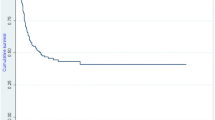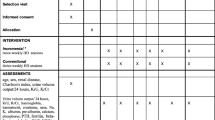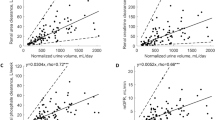Abstract
Background
Residual kidney function (RKF) provides substantial volume and solute clearance even after dialysis initiation. Preservation of RKF is associated with improved outcomes including mortality in patients on both peritoneal and haemodialysis (HD). Factors predicting RKF loss are unclear, including HD modality. Nocturnal haemodialysis (NHD) may result in less aggressive fluid and solute shifts, however, retrospective data suggests frequent NHD may accelerate RKF decline. The aim of the study was to determine if decline in RKF differs between patients undergoing conventional haemodialysis (CHD) versus NHD.
Methods
A prospective observational study of incident HD patients was undertaken comparing patients undertaking CHD (4–5 h, 3 days/week) and NHD (8 h, 3–5 nights/week). Change in RKF was measured by urea and creatinine clearance (48-h interdialytic urine collection) and glomerular filtration rate (GFR) (Cr51-EDTA nuclear scan) at initiation of dialysis (baseline) and 12 months.
Results
A total of 18 incident HD patients were recruited (8 CHD, 10 NHD). Three patients withdrew after baseline (n = 15). Baseline RKF was similar between groups with mean nuclear GFR of 13.3 ± 4.1 mL/min in the CHD cohort vs 13.5 ± 4.6 mL/min in the NHD group (p = 0.89). Baseline urine volume was 2399 ± 950 mLs and 2794 ± 1662 mLs in the CHD and NHD, respectively (p = 0.57). Nuclear GFR declined from time 0 to 12 months to 9.3 ± 2.5 mL/min and 10.4 ± 4.3 mL/min in the CHD and NHD, respectively (p = 0.52). There was a significant decline in 48-h urine volume over 12 months with a mean volume of 1943 ± 1087.0 mLs in the CHD compared to 601.7 ± 315.3 mLs in the NHD (p = 0.01). No significant difference was found in other measures of RKF between groups over 12 months.
Conclusion
This small prospective cohort study found that the loss of residual urine volume was greater in the NHD vs the CHD cohort but there was no difference in other measures of RKF.

Similar content being viewed by others

References
Hemodialysis Adequacy Work G (2006) Clinical practice guidelines for hemodialysis adequacy, update 2006. Am J Kidney Dis. 48(Suppl 1):S2–90. https://doi.org/10.1053/j.ajkd.2006.03.051
Peritoneal, Dialysis Adequacy Work Group (2006) Clinical practice recommendations for peritoneal dialysis adequacy. Am J Kidney Dis 48(Suppl 1):S130–158. https://doi.org/10.1053/j.ajkd.2006.04.013
Bargman JM, Thorpe KE, Churchill DN, Group CPDS (2001) Relative contribution of residual renal function and peritoneal clearance to adequacy of dialysis: a reanalysis of the CANUSA study. J Am Soc Nephrol. 12(10):2158–2162
Obi Y, Rhee CM, Mathew AT et al (2016) Residual kidney function decline and mortality in incident hemodialysis patients. J Am Soc Nephrol 27(12):3758–3768. https://doi.org/10.1681/ASN.2015101142
Termorshuizen F, Dekker FW, van Manen JG et al (2004) Relative contribution of residual renal function and different measures of adequacy to survival in hemodialysis patients: an analysis of the Netherlands Cooperative Study on the Adequacy of Dialysis (NECOSAD)-2. J Am Soc Nephrol 15(4):1061–1070
Bragg-Gresham JL, Fissell RB, Mason NA et al (2007) Diuretic use, residual renal function, and mortality among hemodialysis patients in the Dialysis Outcomes and Practice Pattern Study (DOPPS). Am J Kidney Dis 49(3):426–431. https://doi.org/10.1053/j.ajkd.2006.12.012
Konings CJ, Kooman JP, Schonck M et al (2003) Fluid status in CAPD patients is related to peritoneal transport and residual renal function: evidence from a longitudinal study. Nephrol Dial Transpl 18(4):797–803
Wang AY, Sea MM, Ip R et al (2001) Independent effects of residual renal function and dialysis adequacy on actual dietary protein, calorie, and other nutrient intake in patients on continuous ambulatory peritoneal dialysis. J Am Soc Nephrol 12(11):2450–2457
Mathew AT, Fishbane S, Obi Y, Kalantar-Zadeh K (2016) Preservation of residual kidney function in hemodialysis patients: reviving an old concept. Kidney Int 90(2):262–271. https://doi.org/10.1016/j.kint.2016.02.037
Penne EL, van der Weerd NC, Grooteman MP et al (2011) Role of residual renal function in phosphate control and anemia management in chronic hemodialysis patients. Clin J Am Soc Nephrol 6(2):281–289. https://doi.org/10.2215/CJN.04480510
Shafi T, Jaar BG, Plantinga LC et al (2010) Association of residual urine output with mortality, quality of life, and inflammation in incident hemodialysis patients: the Choices for Healthy Outcomes in Caring for End-Stage Renal Disease (CHOICE) Study. Am J Kidney Dis 56(2):348–358. https://doi.org/10.1053/j.ajkd.2010.03.020
Shafi T, Levey AS (2018) Measurement and estimation of residual kidney function in patients on dialysis. Adv Chronic Kidney Dis 25(1):93–104. https://doi.org/10.1053/j.ackd.2017.09.001
Wong J, Kaja Kamal RM, Vilar E, Farrington K (2017) Measuring residual renal function in hemodialysis patients without urine collection. Semin Dial 30(1):39–49. https://doi.org/10.1111/sdi.12557
Vilar E, Wellsted D, Chandna SM, Greenwood RN, Farrington K (2009) Residual renal function improves outcome in incremental haemodialysis despite reduced dialysis dose. Nephrol Dial Transpl 24(8):2502–2510. https://doi.org/10.1093/ndt/gfp071
Kjaergaard KD, Jensen JD, Peters CD, Jespersen B (2011) Preserving residual renal function in dialysis patients: an update on evidence to assist clinical decision making. NDT Plus 4(4):225–230. https://doi.org/10.1093/ndtplus/sfr035
Schiffl H, Lang SM, Fischer R (2013) Effects of high efficiency post-dilution on-line hemodiafiltration or conventional hemodialysis on residual renal function and left ventricular hypertrophy. Int Urol Nephrol 45(5):1389–1396. https://doi.org/10.1007/s11255-012-0336-4
Penne EL, van der Weerd NC, Blankestijn PJ et al (2010) Role of residual kidney function and convective volume on change in beta2-microglobulin levels in hemodiafiltration patients. Clin J Am Soc Nephrol 5(1):80–86. https://doi.org/10.2215/CJN.03340509
McKane W, Chandna SM, Tattersall JE, Greenwood RN, Farrington K (2002) Identical decline of residual renal function in high-flux biocompatible hemodialysis and CAPD. Kidney Int 61(1):256–265. https://doi.org/10.1046/j.1523-1755.2002.00098.x
Jansen MA, Hart AA, Korevaar JC et al (2002) Predictors of the rate of decline of residual renal function in incident dialysis patients. Kidney Int 62(3):1046–1053. https://doi.org/10.1046/j.1523-1755.2002.00505.x
Graham-Brown MPM, Churchward DR, Hull KL et al (2017) Cardiac remodelling in patients undergoing in-centre nocturnal haemodialysis: results from the MIDNIGHT study, a non-randomized controlled trial. Blood Purif 44(4):301–310. https://doi.org/10.1159/000481248
Liu Y, Ma X, Zheng J, Jia J, Yan T (2017) Effects of angiotensin-converting enzyme inhibitors and angiotensin receptor blockers on cardiovascular events and residual renal function in dialysis patients: a meta-analysis of randomised controlled trials. BMC Nephrol 18(1):206. https://doi.org/10.1186/s12882-017-0605-7
Daugirdas JT, Greene T, Rocco MV et al (2013) Effect of frequent hemodialysis on residual kidney function. Kidney Int 83(5):949–958. https://doi.org/10.1038/ki.2012.457
Rocco MV, Lockridge RS Jr, Beck GJ et al (2011) The effects of frequent nocturnal home hemodialysis: the frequent hemodialysis network nocturnal trial. Kidney Int 80(10):1080–1091. https://doi.org/10.1038/ki.2011.213
Lee MJ, Park JT, Park KS et al (2017) Prognostic value of residual urine volume, GFR by 24-hour urine collection, and eGFR in patients receiving dialysis. Clin J Am Soc Nephrol 12(3):426–434. https://doi.org/10.2215/CJN.05520516
Krediet RT (2017) Preservation of residual kidney function and urine volume in patients on dialysis. Clin J Am Soc Nephrol 12(3):377–379. https://doi.org/10.2215/CJN.00330117
Silva LF, Lopes GB, Cunha TO et al (2014) Coping with fluid restriction and the quality of life in hemodialysis patients with very low or no daily urine output. Int J Artif Organs 37(6):427–435. https://doi.org/10.5301/ijao.5000329
Obi Y, Streja E, Rhee CM et al (2016) Incremental hemodialysis, residual kidney function, and mortality risk in incident dialysis patients: a cohort study. Am J Kidney Dis 68(2):256–265. https://doi.org/10.1053/j.ajkd.2016.01.008
Lin YF, Huang JW, Wu MS et al (2009) Comparison of residual renal function in patients undergoing twice-weekly versus three-times-weekly haemodialysis. Nephrology (Carlton) 14(1):59–64. https://doi.org/10.1111/j.1440-1797.2008.01016.x
Wang AY (2016) Preserving residual kidney function in hemodialysis patients-back in the spotlight. J Am Soc Nephrol 27(12):3504–3507. https://doi.org/10.1681/ASN.2016060693
Pierratos A, Ouwendyk M, Francoeur R et al (1998) Nocturnal hemodialysis: three-year experience. J Am Soc Nephrol 9(5):859–868
Ting GO, Kjellstrand C, Freitas T, Carrie BJ, Zarghamee S (2003) Long-term study of high-comorbidity ESRD patients converted from conventional to short daily hemodialysis. Am J Kidney Dis 42(5):1020–1035
Funding
Supported by International CEC Home Haemodialysis Grant from Baxter.
Author information
Authors and Affiliations
Corresponding author
Ethics declarations
Conflict of interest
The authors have no conflicts of interest to disclose.
Additional information
Publisher's Note
Springer Nature remains neutral with regard to jurisdictional claims in published maps and institutional affiliations.
Rights and permissions
About this article
Cite this article
Skeat, L., Masterson, R., Tjipto, A.C. et al. Residual kidney function in nocturnal vs conventional haemodialysis patients: a prospective observational study. Int Urol Nephrol 52, 757–764 (2020). https://doi.org/10.1007/s11255-020-02419-9
Received:
Accepted:
Published:
Issue Date:
DOI: https://doi.org/10.1007/s11255-020-02419-9



